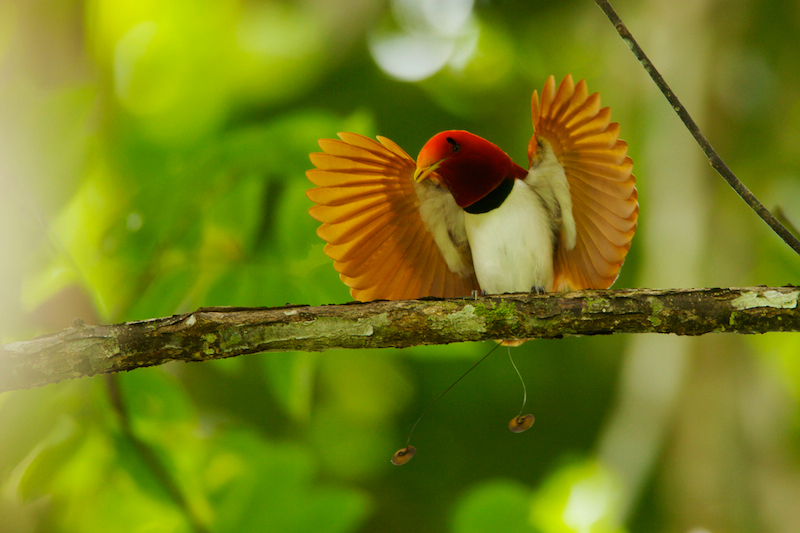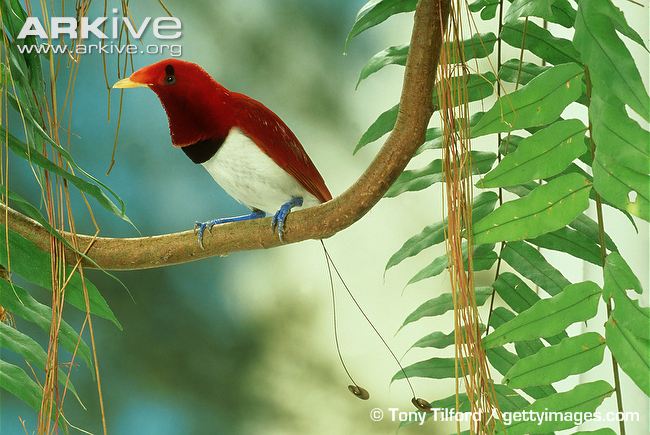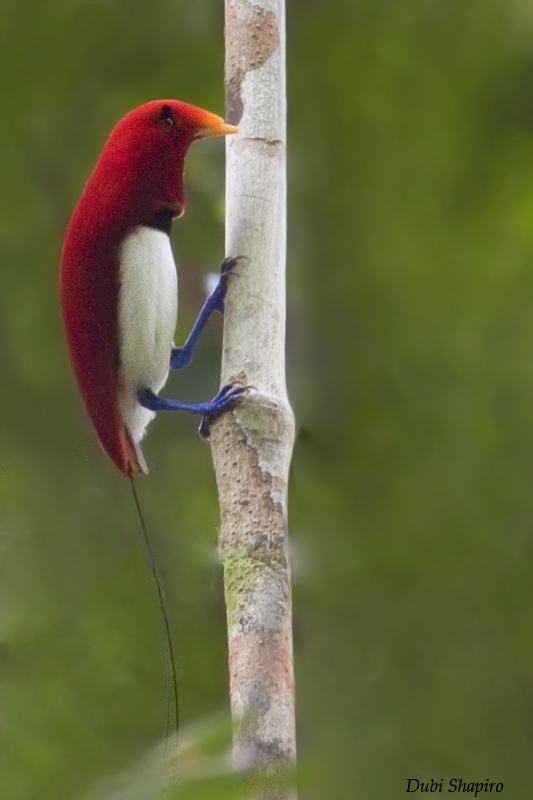
Cicinnurus regius
SUBFAMILY
Paradisaeinae
TAXONOMY
Cicinnurus regius Linnaeus, 1758, East Indies. Two subspecies.
OTHER COMMON NAMES
English: Little king bird of paradise; French: Paradisier royal;
German: Kцnigsparadeisvogel; Spanish: Ave del Paraнso Soberbia.
PHYSICAL CHARACTERISTICS
6.3–7.5 in (16–19 cm), but 12.2 in (31 cm) if central rectrices
of adult males included; female 0.08–0.13 lb (38–58 g), male
0.10–0.14 lb (43–65 g). Head, upperparts, and chin to upper
breast is crimson, with an orange wash on the crown and
darker throat. Jet black spot directly over eye. Narrow, dark
green iridescent breast band with whitish lower breast to vent.
Undertail and mantle feathers olive-brown, with iridescent
green tips to the mantle “cape”. Long central retrices with
brownish disks at the ends. Violet legs, bill ivory-yellow. Females
have dull olive head and upperparts with yellowish underparts
and violet legs.
DISTRIBUTION
Throughout the majority of lowland New Guinea mainland
and Aru, Missol, Salawati, and Yapen islands; from sea level to
3,115 ft (950 m). C. r. regius: Aru, Misool, and Salawati Islands,
the Vogelkop, all of south New Guinea, and the northern watershed
of southeast Papua New Guinea from Huon Gulf to Milne
Bay; C. r. coccineifrons: northern watershed of New Guinea from
the east coast of Geelvink Bay eastward to the Ramu River.
Birds of the north coast of the Huon Peninsula remain to be
subspecifically identified.
HABITAT
Lowland rainforests, gallery forests, forest edges, and disturbed
and tall secondary forests.
BEHAVIOR
An inconspicuous species except for males at their display
trees. Adult males are perhaps more persistent callers than
any other birds of paradise. Courtship involves complex vocalizations,
feather manipulations, and body posturing/movements
including hanging fully inverted and pendulum-like
swinging.
FEEDING ECOLOGY AND DIET
The diet consists of fruits and animals. Foraging occurs at all
forest levels. Birds often join mixed species foraging flocks to
seek arthropods in the lower forest.
REPRODUCTIVE BIOLOGY
Polygynous, with solitary or lekking, sedentary, promiscuous
adult males dispersed at traditional display tree perches.
Breeding occurs at least during March through October. The
open cup nest is built into a tree cavity (unique within family),
within which two eggs are laid. Female builds the nest
and cares for the young without male assistance. In captivity,
incubation lasted 17 days and the nestling period was 14
days.
CONSERVATION STATUS
Not threatened; widespread and abundant.
SIGNIFICANCE TO HUMANS
Plumes of adult males are used for personal adornment but
hunting pressure represents no threat to populations.
Other popular Animals
Photo Gallery of - King bird of paradise




 Animalia Life
Animalia Life